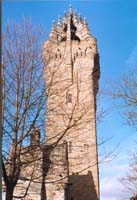

The Battle of Stirling Bridge was a battle of the First War of Scottish Independence and took place on 11 September 1297. Stirling was the main access point to the North of Scotland and the crossing point was the narrow, wooden bridge which crossed the River Forth. The original wooden bridge stood about 180 yards upstream from the existing stone bridge that was built in the 15th century.
Four months after the rising of William Wallace and Andrew Murray began, a massive force of cavalry and infantry marched north to the town of Stirling under the command of John de Warenne, Earl of Surrey and Governor in Scotland for Edward I of England and Hugh de Cressingham, Edward's hated tax collector. John de Warenne underestimated the Scottish forces. He had been victorious over the aristocracy of Scotland at the Battle of Dunbar and believed that he was dealing a disorganised rabble. Warenne delayed crossing Stirling Bridge for several days as he felt sure that the Scots armies would back down due to the military superiority of the English army.
Wallace and Murray's army waited on the Causewayhead side of the river, encamped on the Abbey Craig, where the Wallace Monument now stands. William Wallace and Andrew Murray watched from the hilltop as the English forces, made up up of English, Welsh and Scots knights, bowmen and foot soldiers camped to the south of the river. The English army vastly outnumbered the Scots with 200 to 300 cavalry and 10,000 foot soldiers to the Scots 36 horsemen and 8000 foot.
On the 11th of September 1297, with the Scots refusing to surrender, Warenne's forces started to cross the River Forth. Further downstream, the tidal river was too wide to cross and upstream at Flanders Moss it was too boggy. The wooden structure could only be crossed by two horsemen side by side and it would have taken several hours for the entire English army to cross.
The Scots watched and until over half the English army has crossed the bridge onto an exposed loop on the river that left their flank open to attack, The Scots army which was mainly made up of infantry armed with long spears, rushed down the causeway that ran across the flood plain of the River Forth, forcing ther way along the river bank and attacked the trapped knights, bowmen and foot soldiers. The English cavalry were unable to maneouvre in the confined space and the mounted knights floundered in the marshy ground. In the space of an hour, the Scots had slaughtered the trapped men.
Over half of the English army were cut off and trapped in a confined space with the river to their backs. Some manage to swim across but over 100 men-at-arms and 5,000 infantry were massacred, including Hugh de Cressingham. Cressinghamwas flayed alive by the Scots and Wallace is reputed to have had some of the skin fashioned into a belt to hold his his sword. Andrew Moray was seriously wounded during the battle. He never recovered, dying from his wounds two months later. Only one group of English knights, under Sir Marmaduke Tweng, succeed in cutting their way back to the bridge. The Battle at Stirling Bridge destroyed the myth of English invincibility and was the first battle in Europe where an army of common spearmen, using superior tactics had managed to defeat heavy cavalry.
Only one group of English knights managed to fight their way back to the bridge and after they had crossed, Warenne ordered the bridge to be burned. After the bridge was destroyed Warenne retreated South towards Berwick, leaving the Stirling Castle garrison isolated and the Lowlands open to the rebel advance. The army of William Wallace marched on the North of England. King Edward, who had been angered and humiliated by the Scots victory, retaliated with force and in under a year Wallace's army faced defeat at The Battle of Falkirk.